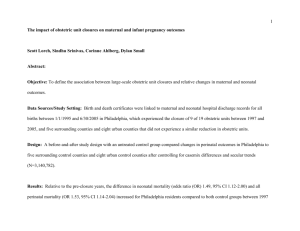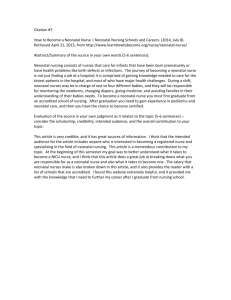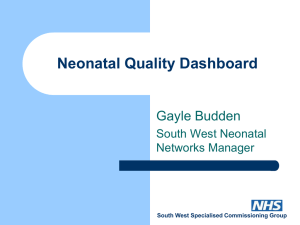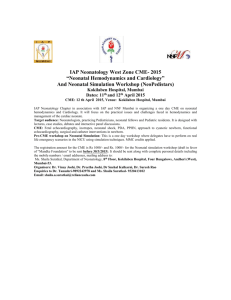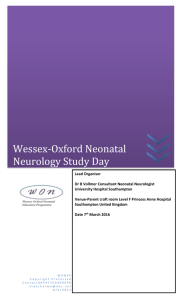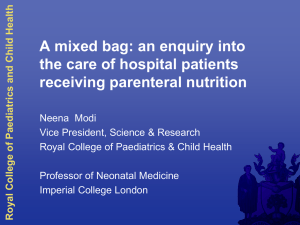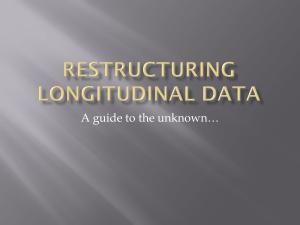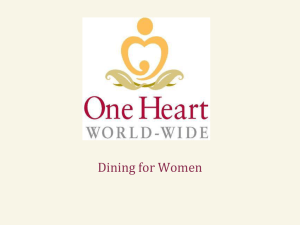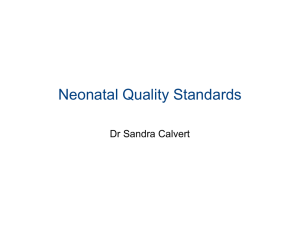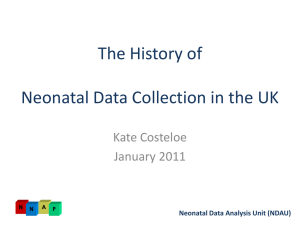1. What is HHAPI - NeSS
advertisement
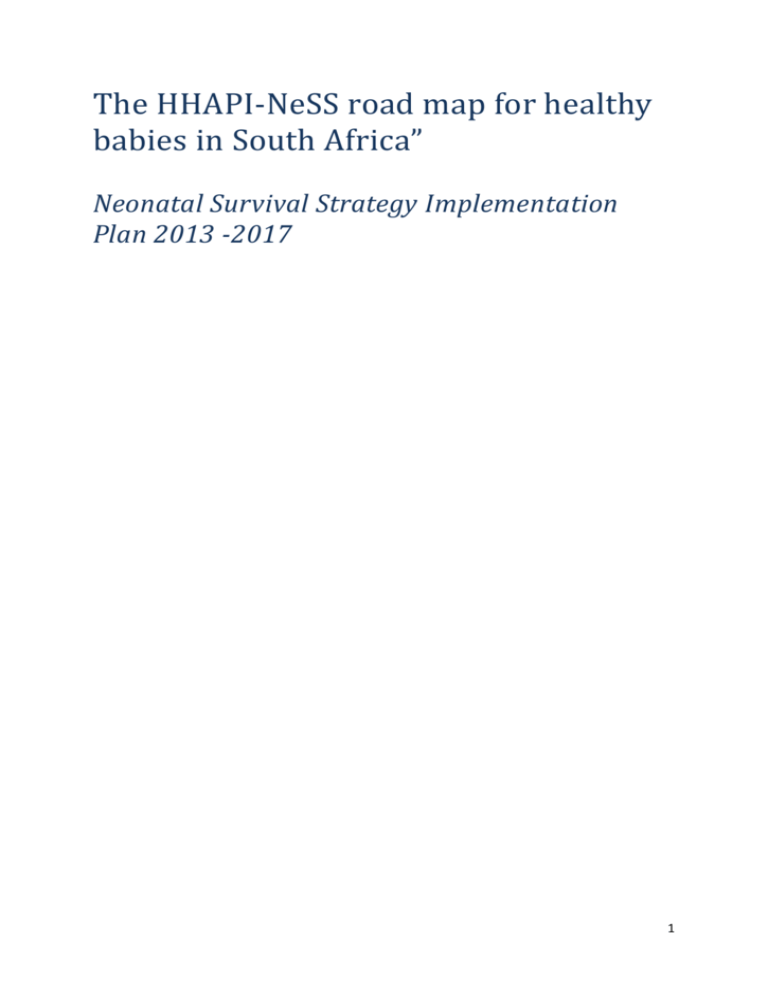
The HHAPI-NeSS road map for healthy babies in South Africa” Neonatal Survival Strategy Implementation Plan 2013 -2017 1 Table of Contents Contents Table of Contents .................................................................................................................................... 2 Acronyms ................................................................................................................................................ 3 Acknowledgements................................................................................................................................. 4 Executive Summary................................................................................................................................. 5 1. What is HHAPI ................................................................................................................................. 6 1.1 What are the 5 Hs ......................................................................................................................... 6 2.0 How is HHAPI-NeSS and the 5 Hs Achieved .................................................................................. 7 3.0 Achieving HHAPI-NeSS .................................................................................................................. 9 4.0 Priority Areas of Action ............................................................................................................... 10 4.1 Essential Services ........................................................................................................................ 13 4.2 Integrated activities for improving maternal and neonatal care................................................ 14 5.0. Monitoring and Evaluation ........................................................................................................ 10 5.1 Overarching national indicators.................................................................................................. 11 Core Programmatic Indicators ...................................................................................................... 11 6.0 Tools and Resources ................................................................................................................... 11 Appendix 1: Menu of Activities ......................................................................................................... 13 2 Acronyms APH Antepartum haemorrhage AIDS Acquired immunodefciency syndrome AGA Appropriate for gestational age ANC Antenatal care ARV Anti-retroviral AZT Azidothymidine (antiretroviral drug) BBA Born before arrival CHW Community health worker CPAP Constant positive airway pressure DCST District clinical specialist team HIV Human immuno deficiency virus ICU Intensive care unit KMC Kangaroo mother care LBW Low birth weight NAMMPEMCO National Perinatal Mortality and Morbidity Committee NCCEMD National Committee on the Confidential Enquiries into Maternal Deaths NeSS Neonatal Survival Strategy NMR Neonatal mortality rate NND Neonatal death PROM Prolonged rupture of membranes 3 Acknowledgements (TBD) 4 Executive Summary (To be completed) 5 The HHAPI-NeSS road map for healthy babies in South Africa aims to provide a road map for improving newborn care in South Africa. The road map contains no new recommendations, approaches or actions, but rather aims to provide a framework for operationalizing the key NCCEMD and NaPeMMCo recommendations for improving newborn and maternal care. The road map outlines clear steps and roles and responsibilities at all levels of health care delivery, and sets targets and timelines towards expected results. It also outlines a monitoring plan highlighting regular reviews at all levels. 1. What is HHAPI - NeSS HHAPI is an acronym used by NaPeMMCo to summarize their key recommendations regarding the actions that are needed to improve newborn care and neonatal survival, namely: Improve the Health System for mothers and babies Improve the knowledge and skills of Health Care providers in maternal and neonatal care Reduce deaths due to Asphyxia Reduce death due to Prematurity Reduce deaths due to Infection Implementation of interventions for each of the recommendation forms the basis of the Newborn Survival Strategy (NeSS). The HHAPI-NeSS road map also includes the 5 Hs. 1.1 What are the 5 Hs Improvements in neonatal survival are critically dependent on improvements in the quality of maternal care. Thus the road map incorporates the key NCCEMD recommendations which specifically address improvements in maternal care and survival, namely the 5 H’s. These include Reduce deaths due to HIV/AIDS Reduce deaths due to Haemorrhage Reduce deaths due to Hypertension Improve Health worker training and Health system strengthening 6 2.0 Interventions to achieve results for HHAPI and the 5 Hs Essential packages of care for mothers and newborns have been defined and are shown in Annexure A. Likewise a set of joint priority actions have been identified and are listed in the table below. RECOMMENDATION INTERVENTIONS Improve the Health Ensure 24 hour access to functioning emergency obstetric and neonatal System for mothers care (both basic and comprehensive). Dedicated ambulances, maternal and babies waiting homes, KMC sites in all hospitals etc. Ensure accessible and appropriate contraceptive services for all women which are integrated into all levels of health care and are available on site for women post-miscarriage and postpartum women Improving skills and Train all health care workers involved in maternity and neonatal care in skills of Health Care the ESMOE-EOST programme (including Helping Babies Breathe) and in providers in managing healthy and sick newborn infants (SA-INC) maternal and Train all health care workers who deal with pregnant women in HIV neonatal care advice, counselling, testing and support (ACTS), initiation of HAART, monitoring of HAART Reduce deaths due Ensure that labour is monitored appropriately by a skilled birth attendant to Asphyxia Ensure all birth attendants are skilled at a minimum in neonatal bag and mask ventilation Ensure that the partogram is used to monitor labour and the fetus and mother are monitored according to the prescribed norms ensuring proper data interpretation. Reduce death due to Ensure that corticosteroids are given to every women in preterm labour Prematurity Ensure antibiotics are given with preterm premature rupture of membranes Ensure the appropriate hospitals are skilled in the used of nasal CPAP Ensure that all mothers of immature infants have easy access to KMC Reduce deaths due Promote breastfeeding (especially exclusive breastfeeding) to Infection Ensure strict adherence to basic hygiene in labour wards and nurseries Ensure presumptive antibiotic therapy for at risk newborns is available Ensure case management of neonatal sepsis, meningitis and pneumonia Reduce deaths due Promote “Know your status” and “plan your pregnancy” messages in to HIV/AIDS communities and the health sector; ensuring non judgemental approaches. Ensure every maternity facility is able to screen for HIV infection and perform early initiation of HAART therapy; and to recognise and treat coinfections, especially respiratory infections. Ensure that all mothers and their infants receive the full package of PMTCT interventions Reduce deaths due Promote preventive interventions: community education, prevent to Haemorrhage prolonged labour, prevent anaemia; use of safe methods for induction of labour and practice active management of the third stage of labour (AMSTL). Severe obstetric haemorrhage must have the status of a ‘major alert’ requiring a team approach; with immediate attention to diagnosis of the cause of haemorrhage, resuscitation and stepwise approach to arresting the haemorrhage. 7 Reduce deaths due to Hypertension Calcium supplementation provided to all women throughout antenatal care and ensure detection, early referral and timely delivery of women with hypertension in pregnancy Severe hypertension, imminent eclampsia, eclampsia and HELLP syndrome must be recognised as life threatening conditions requiring urgent attention. All maternity facilities must be able to administer magnesium sulphate to prevent convulsions, administer rapid acting agents to lower severely raised blood pressure , provide close monitoring prior to and following delivery and manage fluid balance safely. Promotion of Family Planning Services (women, their partners, families and communities). KEY STEPS TOWARDS ACHIEVING THE RESULTS OF HHAPI – NeSS Establish teams and focal persons Assess Situation (bottleneck analysis) Develop costed evidenceresultsbased plan tailored to context Implement Plan Conduct Ongoing Monitoring to track progress Conduct Regular Reviews Document Best Practices and lessons learned 1. Establish teams that consist of champions and drivers at the national, provincial, district, and facility and community levels. Identify a focal person / team leader that can lead the process and support the teams, and facilitate implementation of the plan (step 4 below). 2. Assess the situation/Conduct a situation analysis at the national, provincial, district and facility level. At the provincial, district and facility level, this should include a training assessment and a services and resources assessment. 3. Develop a costed, evidence and results based plan at each level (provincial, district, facilty). The plan should be based on the data collected through the assessment above. 4. Implement the plan as per timelines 5. Ensure ongoing monitoring of key indicators at different levels to track progress 6. Conduct regular reviews at each level to identify challenges and make mid course corrections as needed 7. Document best practices and lessons learned The diagram below details what each step entails for the specific level. 8 • Identify focal person. team leader • establish teams • Conduct situation analysis includes training needs • Identify challenges and actions needed • Develop plan • Select 4-5 priority actions for year 1 and year 2 • Finalize national training package • Train master trainers to facilitate training implementation at the provincial level • Map existing services, identify gaps • Set national level targets for monitoring District Facility • Identify focal persons • Conduct facility level assessment to determine which facilities will be targeted • Implement priority actions • monitor and track progresss Ongoing monitoring Provincial Ongoing Monitoring Ongoing Monitoring National • conduct assessment • identify priority actions • Ensure essential staff are trained • Implement priority actions and interventions • monitor and track progress 3.0 Achieving HHAPI-NeSS The table below details the implementation of HHAPI-NeSS at the National, Provincial, District and Facility level April 2013 –March 2015. Activity Finalize the national training package Create a Master trainer database Train master trainers in national training package Identify provincial focal person Identify district focal person DCST teams Conduct situation assessment (services, resources and training) Develop a provincial inventory of fully trained, partially trained, and inadequately trained health care workers Set national targets for key indicators Develop training plan based on assessment Master trainers to conduct provincial training based on training assessment Select 4-5 priority areas to achieve HHAPINeSS Identify specific interventions and actions to address the priority areas Implement interventions and activities for year 1 Monitor key indicators Responsibility National National National Province Province District Province and District Province Timeline June 2013 June 2013 June 2013 June 2013 June 2013 June 2013 June 2013 National Province Province June 2013 June 2013 Sept 2013 Province Dec 2013 Dec 2013 District Facility Facility District Province March 2014 June 2013 March 2014 9 Select 4-5 priority areas to be implemented in Y2 Identify specific interventions and actions to address the priority areas Implement interventions and activities for year 2 Monitor key indicators National Province District Facility Facility District Province National June 2014 June 2014 March 2015 March 2015 4.0 Priority Areas of Action To effect change (and improve maternal and newborn survival every level of health management and care and the community needs to be involved. The recommendations set forth by the two ministerial committees NCCEMD and NaPeMMCo, as well as the strategies in which actions are requested from every level of management (including the policy makers to the clinic managers, health care providers, community and the Faculties of Health Sciences and Nursing colleges, the College of Medicine and Health Professions Council). These activities are documented in appendix 2. It is important to highlight that introducing everything/all activities at once is not possible, and individual districts will need to prioritise and select the interventions that will have the greatest impact. On a national level, the interventions that will result in the greatest reduction of deaths are those that focus onpreventing, screening for and managing mothers and their infants HIV infection (Lancet SA series). The intervention that will result in the second largest reduction in deaths are those interventions that focus on improving basic and comprehensive emergency obstetric and neonatal care (Lancet SB series data worked out by Kate Kerber for SA). A number of training packages and tools for improving and monitoring provision of newborn care are available and these are listed in Appendix x. 5.0. Monitoring and Evaluation Continuous monitoring is needed to track progress in implementation. The DHIS child health and nutrition indicators form the core source of monitoring. Targets for reducing newborn mortality rates in all facilities have been established, and progress in moving towards these targets will be tracked. Monitoring of annual business plans at the district and provincial levels to track progress and prioritize activities identified as bottlenecks. Special surveys will be implemented as needed to gain in-depth analysis of the NeSS. Data flow: Indicators will be tracked quarterly to monitor and track progress in implementation of activities. Data will feed into a quarterly data monitoring reports that will be shared at all levels. Data 10 collected at each level will vary in the degree of detail. The most detailed data will be collected at the facility level, this will feed into district data, provincial data and national data through DHIS. The national level data will provide a broad overview of progress in the country. 5.1 Overarching national indicators (TBC) The overarching national indicators will be used at national level and will inform global reporting. Numerator Denominator Source 11121314152012 2013 2014 2015 2016 Core Programmatic Indicators Indicator Numerator Denominator Source 11201 2 Indicator Neonatal Mortality Rate Child Under-5 Mortality Rate 122013 132014 142015 %Live births < 1.0Kg+ %Live births 1.0kgs 1.49Kgs %Live births 1.5 -2.5 kgs Still births (1.0kgs) ENND < 1.0kgs ENND 1.0 -1.49kgs Still births> 2.5kgs PND FSB FSB +ENND 6.0 Tools and Resources 11 15201 6 The following list documents tools and resources that have been developed in South Africa and used to improve newborn care. Every newborn care plan should consider how these tools should can be used in order to to achieve HHAPI-NeSS. Training SA-INC (5 days) Helping Baby’s Breath Routine care for newborns charts and training Management of Sick and Small Newborn Charts and Training Perinatal Education Programme (PEP) Resource: self study/resource Additional resource: Guidelines for DCST for Improving Maternal and Neonatal Care 2013 Routine Care -Newborn Record Maternity Perinatal Problem Identification Programme 12 Appendix 1: Essential Services Service Delivery at specific Time Points Antenatal care (mother and fetus) Intrapartum care (mother and fetus) Immediate post partum care (mother and neonate) Monitoring and evaluation for respiratory support eg: CPAP, IPPV Immediate post partum and continuing care (mother and neonate) Rapid and successful communication and transfer of the at risk neonate to the appropriate level of care Services to be included Early booking at the ANC ensured; the well being of the fetus and mother/ pregnancy is addressed byl roll-out of the BANC system Early identification of the high risk fetus / pregnancy Antenatal steroids in premature labour IAP when maternal infection suspected e.g. in PPROM Integrate TB screening into at risk patients (+ symptoms or HIV co-morbidity) Ca supplementation to reduce hypertension risk Ensure all mothers have tetaus toxoid vaccination (small no’s RSA) Early and appropriate referral of high risk pregnancy to specialist centres Early/appropriate implementing of PMTCT with monitoring especially of the viral load /and early HAART Adequate monitoring of the fetus will ensure early detection of problems Appropriate and early emergency management and referral Early and appropriate choices of delivery Availability of C/S facilities (theatres + staff) Ongoing fire drills in resuscitation to be diarized for the year A care giver skilled in resuscitation at every delivery ESMOE with neonatal resuscitation (HBB integrated as it has a competency test attached to pass) Correct management of mother/ fetus / newborn delivered via meconium stained liquor Care of the 5 basic neonatal principles: 1. to maintain a normal temperature 2. to maintain a normal glucose 3. treat suspected infection 4. provide oxygen (at appropriate levels) if necessary 5. early feeds (breast milk) Keep mom and baby together if possible Early identification of the neonate with respiratory distress allowing; Early intervention with respiratory support and emergency management e.g. CPAP (need and clinical management abilities ofstaff) Early discussion for possible transfer if not improving and bed available at next level of care These are non-negotiable strategies: 1. optimize breast feeding/breast milk 2. KMC and KMC follow-up 3. Mother-baby-friendly hospital initiative 4. Optimise PMTCT programme 5. Full Implementation of the EPOC guidelines for mother and baby This is an independent factor for poor outcome when a sick neonate is transferred without a good retrieval system Transport staff (ambumedics / paramedics) require specific training to care for the sick or preterm neonate This also includes appropriate (eg. Transport incubators, O2, etc) and rapid transfers from level 3 hospitals to step-down facilities. This is known as retro – referrals and are non-acute referrals 13 To these key essential services, the following overarching services can be added: Monitoring and evaluation Audit care at facility level with institutionalising PPIP and making it functional. It requires 3 components which will render it functional: a. Data capturing of all deliveries, births and perinatal deaths. b. Entering & identifying the causes of deaths at regular minuted mortality and morbidity meetings c. Instituting management change and policies as a result of the facility data Adequate resources Human resources according to the norms and standards Equipment - essential list for neonatal nurseries Training – in service training must be ongoing to all staff dealing with neonates eg: use of DCST LINC toolkit, PEP manuals etc 1.2 Integrated activities for improving maternal and neonatal care The NaPeMMCO and NCCEMD committees have both developed recommendations for reducing maternal and neonatal deaths based on analyses of maternal and neonatal deaths from 2008-2011. However, making recommendations is not sufficient, and key interventions that would reduce maternal and neonatal mortality were identified. Both committees have been through a thorough process of analysing what it would take to implement these key interventions. A list of key actions in which all levels of professionals involved in health and the community (role players) are involved and need to perform so that these key interventions will actually be implemented has been developed. Figure 1 gives a flow diagram of responsibilities for actions for implementing strategies for saving lives. There is considerable overlap between interventions to prevent maternal deaths and neonatal deaths; hence the requested actions have been integrated into requested actions from all role players to reduce maternal and neonatal deaths as a single entity. Figure 1. A flow diagram of responsibilities for implementing actions to save lives 14 The recommendations of both committees can be summarised as improving the quality of care provided for women and/or their neonates in 6 conditions namely HIV infection, obstetric haemorrhage, complications of hypertension,interpartum care, birth asphyxia, premature babies and infection in the babies. This would be achieved by improving the training of the health care providers and the health system by improving access to care through the continuum (during pregnancy, in childbirth and in the puerperium. (The key interventions for reducing maternal and neonatal deaths include those given by the WHO but applied the South African situation). Usually saving lives means improving a combination of the quality of care received and the coverage of the intervention. The coverage of health care facilities is good in South Africa, and it is the quality of care provided that needs significant improvement. The quality of care is dependent on the activities of the health care managers in proving the necessary facilities (i.e. equipment, drugs and staff) and access for the user which is mainly transport; and is also dependent on the knowledge, skills and attitude of the health care provider (Figure 1). Hence the recommendations of both committees have targeted improving the quality of care received by women and their babies by identifying the key interventions that will reduce maternal deaths due to HIV infection, obstetric haemorrhage and complications of hypertension and neonatal deaths due to birth asphyxia, prematurity and neonatal infection. Implementing these interventions involves the health care managers, health care providers and the user and her community. To achieve full implementation every level of health care and the community needs to be involved and each role player should be responsible for some activities which if performed will result in a reduction of maternal and neonatal deaths. In addition, strategies have been developed based on the key causes of mortality (NaPeMMCo). The table below highlights intervention by cause of mortality. Table: Interventions by Cause of Mortality KEY CAUSE OF MORTALITY Improve the health system for mothers and babies: Improve knowledge and skills of health care providers: Most hypoxic deaths are as a result of inadequate intrapartum care provided by health care providers. Reduce deaths due to INTERVENTIONS Contraception, including for post miscarriage and postpartum 24 hour access to functioning emergency obstetric and neonatal care including clear referrals routes with dedicated obstetric and neonatal ambulances Maternal waiting homes, KMC sites in all hospitals CEOs to ensure that there is no rotation of nursing staff providing neonatal care Train all health care workers providing maternity and neonatal care in the ESMOE-EOST programme and in managing the immature infant using the SA INC toolkit Train all health care workers who deal with pregnant women in HIV advice, counselling, testing and support , initiation of HAART, monitoring of HAART Train all health care workers in correct management of intrapartum care (use of the Partogram, 3rd stage of labour) Every women in labour must be monitored appropriately by a skilled 15 asphyxia: Asphyxia was the leading cause of neonatal deaths in the birth category >1000g. 70% of death in the >2,5kg group were classified as hypoxia related. birth attendant All birth attendants must skilled in at least bag and mask ventilation of the neonate The partogram must be used to monitor labour according to prescribed norms All complicated and obstructed labours must have access to Caesarean section when indicated A birth attendant skilled in neonatal resuscitation can reduce deaths to hypoxia by up to 40%. Reduce deaths due to prematurity: The use and application of nasal CPAP at a district hospital can reduce mortality of this group by up to 40%. Reduce deaths due to infection: Infection is the third largest cause of neonatal deaths in all weight categories, but highest in the 1000g2000g group Corticosteroids must be given where possible to every women in preterm labour Antibiotics must be given to every women with preterm premature rupture of membranes All hospitals (especially district hospitals)must have staff skilled in the use of nasal CPAP All mothers of immature infants have easy access to KMC There must be strict adherence to basic hygiene in labour wards and nurseries. D-germ alcohol sprays, soap, clean water and paper towels must be available in all nurseries as essential consumables There must be presumptive antibiotic therapy for newborns at risk of bacterial infection There must be case management of neonatal sepsis, meningitis and pneumonia As breast milk provides the best nutrition and protection for the preterm baby, districts should provide breast milk (not preterm formulas) to all preterm babies by the establishment of human milk banks. Infection dashboard must be introduced in all neonatal nurseries to reduce infections by heightening awareness and surveillance of infection rates. 16 APPENDIX 2: ROLES AND RESPONSIBLITIES FOR KEY ROLE-PLAYERS Below is a menu of activities directed at the various levels of care. Much of the actions are repetitive, but this is to ensure the activities are carried out at every level of care and that everyone is pulling in the same direction. Activities are grouped according to the following categories: Community education; Access to care; Health care management; Health care provider training; and Monitoring and evaluation. The tables below highlight activities requested from the various levels. There is a separate table for each level. TABLE: ACTIVITIES REQUESTED FROM POLICY MAKERS Activities requested from Policy Makers (Minster of Health and Provincial MECs) Community Education Access to care Health care management Promote the message that all pregnant women should be delivered by a skilled birth attendant in an environment that has sufficient facilities to ensure a safe birth Ensure that standard basic educational maternal and neonatal health messages are developed and available (contents are given below) Improve access by o Considering developing maternity waiting homes in or near health care facilities o Considering the use of motor-bike ambulances in remote areas with community health workers as “ambulance” drivers o Fast track the development of national and provincial staffing and equipment norms for maternity units, caesarean section theatres and nurseries (based on SA-INC toolkit) Promote and integrate contraceptive services at every contact with health service. Provide widespread advocacy to achieve the MDGs 4 and 5. (Prioritise managing HIV in pregnancy; improving intrapartum care to reduce neonatal deaths due to hypoxia and maternal deaths due to haemorrhage and hypertension; and managing small and sick premature baby and the prompt management of neonatal infections.) Prioritise and target districts with most severe maternal and neonatal mortality rates Promote the establishment, use of and support the district clinical specialist teams to facilitatethe implementation of the recommendations Actively support the following health strategies o Current HIV and AIDS strategy o Strategies to prevent and manage obstetric haemorrhage 17 Monitoring and evaluation and hypertension (detailed below in each section) but include prevention by iron, folate and calcium supplementation, taking the blood pressure and measuring the haemoglobin at antenatal care, provide emergency care training and protocols for emergencies in obstetric haemorrhage and hypertension using the ESMOE programme and by provide facilities appropriately equipped and staffed for basic (CHCs) and comprehensive emergency obstetric care (District hospitals and above). o Promote strategies to improve intrapartum care and care of the infants with asphyxia and who are born premature (detailed below). These should include use of the partogram for every woman in labour, the use of evidenced based interventions to reduce neonatal deaths, the use of antenatal corticosteroids and antibiotics for women with preterm premature rupture of membranes, ensure the health care providers can resuscitate a newborn babies using ESMOE and HBB; use the Essential Newborn Care the management of small and sick neonates booklet. o Promote strategies to prevent neonatal infections. These should include ensuring that all health care facilities conducting births have infection control measures in place, havemilk banks and/or milk pasterurisation at all facilities to promote breast feeding including those HIV exposed at birth; KMC practice to be enforced as a basic requirement for all facilities where babies are born. Ensure monitoring and evaluation of the implementation of the recommendations by o Promoting maternal and perinatal morbidity and mortality reviews and local use of the data o Considering making Institutional MMR due to Obstetric Haemorrhage and Hypertension as indices and suggest monitoring progress in provinces and districts 6 monthly o Considering making the fresh stillbirth + early neonatal death for babies 2.5kg+ rate as a marker to be tracked for the quality of intrapartum care o Considering making the early neonatal death rate for neonates between 1.0kg and 1.49kg as a marker for the quality of neonatal care. o Considering introducing an accreditation system for hospitals for caesarean sections o Considering introducing an accreditation system for neonatal care as per SA-INC o Considering dedicated National Maternal and Perinatal Audit Units like the UK “CEMCH” Table: Activities requested from National and Provincial Director Generals/HODs Activities requested from the National and the Provincial Director Generals/ HODs 18 Community Education Access to Care Determine the standard basic health educational messages but these must include; o Starting folate supplementation as soon as the couple start planning a pregnancy o Importance of booking early and attending antenatal clinics regularly healthy eating and iron supplements to reduce anaemia in pregnancy; o Importance of attending with any bleeding in pregnancy ; o Importance of labour with skilled birth attendant and early attendance in labour to prevent prolonged labour; o Planning of transport when in labour, warning of dangers of self-use of oxytocic agents to encourage labour; o Home base life-saving skills in the event of home delivery with bleeding (uterine massage, baby to breast, empty bladder, keep baby warm with providing skin to skin care (KMC) , clamp and cut cord, early breastfeeding). Start calcium supplementation once pregnancy diagnosed to reduce hypertension in pregnancy Know the importance of early warning signs for eclampsia/severe preeclampsia; i.e. Headache, swelling blurred vision etc. Know the importance of early warning signs for infection of the newborn baby i.e. high pitched cry, unable to feed, red swollen umbilical stump, etc.) Encourage all mothers to breast feed their babies within an hour after birth Encourage everyone to know their HIV status To plan their families. To start antenatal care in the first trimester Pregnant women must be attended during labour by a skilled birth attendant in a facility that has the appropriate resources Develop Videos, Radio booklets, community theatre, community health workers, NGOs and women’s groups. Revitalise education at ANC which should include neonatal care issues such as care of the preterm baby Ensure emergency transport facilities must be available for all pregnant women in need (at any site)Ensure transport issues are addressed with communities Consider introducing Maternity Waiting Homes Ensure transport from L1/CHC to higher levels be continuously available and preferably on site; in remote areas consider the use of motor bike ambulances stationed at clinics and with a CHW as "ambulance" driver Ensure criteria for referral and referral routes must be 19 Health Management Health Care Provider Training established and utilized appropriately in all provinces Ensure staffing and equipment norms are established for each level and for every health institution concerned with the care of pregnant women and their babies. This includes adequate staffing levels for 24 hour acute care in labour and postpartum; but also for maternity theatres and monitoring post-delivery and post CS. Until norms are provided use the WHO labour ward norm of one midwife in labour ward per 175 deliveries per year. Ensure all CHCs can provide basic emergency care, namely ability to give magnesium sulphate, oxytocics, antibiotics, manual removal of the placenta, manual vacuum aspiration of incomplete miscarriage, assisted delivery, bag and mask ventilation of newborns, and provide basic routine care of the neonate (as per SAINC ), namely provide adequate warmth for baby (KMC), treat infections promptly, feeding of preterm neonates, provision of oxygen for babies in respiratory distress and monitoring of blood glucose, bag and mask ventilation of newborns and HIV testing and antiretroviral treatment if indicated. Ensure all district hospitals can provide comprehensive emergency obstetric care, namely basic antenatal care (listed above) and the ability to give a blood transfusion and perform a caesarean section. Ensure all district hospitals can provide routine and essential newborn care, namely the management of the small and sick baby (part of SA-INC) and the ability to provide basic nasal CPAP. Ensure that district hospitals and CHC can pasteurize breast milk and thus have the necessary equipment available for pasteurization and or milk banking Ensure the supply chain for essential drugs; iron, folate oxytocin, ergometrine, magnesium sulphate, antihypertensives (nifedipine & alpha-methyl dopa); phenobarbitone, midazolam, iron syrup, multivitamins, antiretroviral drugs to be seen as essential drugs and never in short supply Ensure basic monitoring equipment is available especially baumanometers, pulse oxyimeters, heamoglobinometers, on-site HIV testing kits, transcutaneous bilirubinometers, infusion pumps are appropriate and adapted for neonatal use are available at all institutions conducting births. Provide support for the training of doctors and midwives in ESMOE+HBB, by instructing CEOs to give time for the doctors and midwives to have the training and insist on emergency obstetric simulation training exercises taking place at least monthly in their institutions 20 Monitoring and evaluation Ensure Emergency Obstetric Simulation Training exercises are preformed routinely at every institution conducting births, these must include neonatal resuscitation Ensure these key activities become part of the key performance areas of the appropriate managers. Introduce a national standardised birth registeras the major data sourcefor DHIS and audit programmes Introduce a national standardized neonatal register for all district hospitals as per the SA-INC toolkit Ensure death review meeting occur where maternal death notification forms are completed and neonatal deaths are discussed and minutes are kept of the meeting Consider making Institutional MMR due to obstetric haemorrhage and hypertension as indices and monitor progress in districts and provinces 6 monthly Consider making the fresh stillbirth + early neonatal death for babies 2.5kg+ rate and the early neonatal death rate for neonates between 1.0kg and 1.49kg as a indices for the quality of intrapartum and neonatal care respectively and monitor progress in districts and provinces 6 monthly Consider introducing process evaluation of maternal deaths due to haemorrhage and hypertension, intrapartum asphyxia and prematurity over 1 kg. Consider introducing an accreditation system for hospitals for caesarean sections Consider introducing an accreditation system for district hospitals as per SA-INC Have six monthly reports on proportion of women testing for HIV, proportion found positive, proportion started on ARVS and on dual therapy, proportion HIV infected mothers and infants seen within 6 days of discharge and at 6 weeks, proportion of HIV exposed infants that have a PCR at 6weeks and proportion of HIV infected mothers that have a CD4 count at 6 weeks TABLE: ACTIVITIES REQUESTED FROM PROVINCIAL MCWH MANAGERS AND DISTRICT MANAGERS Activities requested from the provincial MCWH managers and the District Managers Community education Ensure the standard basic maternal health educational messages are spread throughout the district including; Starting folate supplementation as soon as the couple start planning a pregnancy, healthy eating and iron supplements to reduce anaemia in pregnancy; Importance of booking early and attending antenatal clinics regularly Importance of attending with any bleeding in 21 Access to Care Health Management pregnancy ; Importance of labour with skilled birth attendant and early attendance in labour to prevent prolonged labour; Planning of transport when in labour, warning of dangers of self-use of oxytocic agents to encourage labour; Home base life-saving skills in the event of home delivery with bleeding (uterine massage, baby to breast, empty bladder, keep baby warm with providing skin to skin care (KMC) , clamp and cut cord, early breastfeeding). Start calcium supplementation on diagnosis of pregnancy to reduce hypertension Know the importance of early warning signs for eclampsia/severe preeclampsia; i.e. Headache, swelling blurred vision etc. Know the importance of early warning signs for infection of the newborn baby i.e. high pitched cry, unable to feed, red swollen umbilical stump, etc.) Encourage all mothers to breast feed their babies within an hour after birth Develop Videos, Radio booklets, community theatre, community health workers, NGOs and women’s groups. Revitalise education at ANC which should include neonatal care issues such as care of the preterm baby. Encourage everyone to o Know their HIV status o To plan their families. o To start antenatal care in the first trimester o Pregnant women must be attended during labour by a skilled birth attendant in a facility that has the appropriate resources Address transport issues with communities Consider introducing Maternity Waiting Homes Ensure availability of emergency transport facilities for pregnant women in need (at any site) Ensure transport from L1/CHC to higher levels be continuously available and preferably on-site especially in remote areas. Consider the use of motor bike ambulances stationed at clinics and with a CHW as "ambulance" driver Ensure criteria for referral and referral routes are established and utilized appropriately. Ensure staffing and equipment norms are established for each level and for every health institution concerned with the care of pregnant women and her baby and form part of accreditation criteria for maternal services. Ensure adequate staffing levels for 24 hour acute care in labour and postpartum; but also for maternity theatres and monitoring post-delivery and post CS. 22 Until norms are provided use the WHO labour ward norm of one midwife in labour ward per 175 deliveries per year. Ensure all CHC can provide basic emergency care, namely ability to give magnesium sulphate, oxytocics, antibiotics, manual removal of the placenta, manual vacuum aspiration of incomplete miscarriage, assisted delivery, bag and mask ventilation of newborns, and provide basic routine care of the neonate (as per SAINC ), namely provide adequate warmth for baby (KMC), treat infections promptly, feeding of preterm neonates, provision of oxygen for babies in respiratory distress and monitoring of blood glucose, bag and mask ventilation of newborns and HIV testing and antiretroviral treatment if indicated. Ensure all district hospitals can provide comprehensive emergency obstetric care, namely basic antenatal care and the ability to give a blood transfusion and perform a caesarean section. Ensure dedicated telephonic linkages for consultation for emergencies between referring and referral site are available. (Use the standard SBAR charts for referrals) Ensure that district hospitals and CHC can pasteurize breast milk and thus have the necessary equipment available for pasteurization and or milk banking Ensure the supply chain for essential drugs; iron,folate oxytocin, ergometrine, magnesium sulphate, antihypertensives (nifedipine & alpha-methyl dopa), phenobarbitone, midazolam, iron syrup, multivitamins, and antiretroviral drugs Ensure basic monitoring equipment is available such as baumanometers, pulse oxyimeters, heamoglobinmeters,on-site HIV testing kits transcutaneous bilirubinometers, infusion pumps are appropriate and adapted for neonatal use are available at all institutions conducting births. Ensure that all women in labour are monitored on the partogram and provide continuing medical education on the use for the partogram Introduce practical skills training and training for caesarean section Introduce Early Warning Charts. Postoperative and postpartum monitoring must occur, be audited and enabled with appropriate equipment and early warning monitoring charts. Protocols on the management of important maternal conditions (especially HIV/AIDS, obstetric Haemorrhage and hypertension) causing maternal deaths must be available and utilised appropriately in all institutions (including facilities only providing antenatal and postnatal services) where women deliver. All midwives 23 Health Care Provider Training Monitoring and Evaluation and doctors must be trained on the use of these protocols. An eclampsia box must be on the resuscitation trolley of all institutions conducting births and must include a checklist of action for managing eclampsia An obstetric haemorrhage box must be on the resuscitation trolley of all institutions conducting births and must include a checklist of action for managing obstetric haemorrhage Protocols on the management of important neonatal conditions (especially neonatal infections, hypoxic babies and premature babies) causing neonatal deaths must be available and utilized appropriately in all institutions (including facilities which only provide antenatal and postnatal services) where women deliver. All midwives and doctors must be trained on the use of these protocols bound in a pocket-sized booklet for easy access. Provide support for the training of doctors and midwives in ESMOE and SA-INC, by instructing CEOs to give time for the doctors and midwives to have the training and insist on emergency obstetric simulation training exercises taking place at least monthly in their institutions Ensure midwives, MOs in CHCs, District Hospitals and above undergo ESMOE and HBB training Ensure health care institutions performing deliveries perform and score Emergency Obstetric Simulation Training exercises at least monthly and involve all their maternity staff. These must also include neonatal resuscitation. (A roster of those attending and the score must be passed onto the CEO of the institution) Ensure these key activities become part of the key performance areas of the appropriate managers. Training should be provided for all health professional working in maternity units in practical obstetrical and surgical skills. Skills should be provided in anaesthesia, especially in level 1 institutions Ensure training of midwifery staff, neonatal nurses and doctors in KMC, oxygen administration, where appropriate nasal CPAP, infection prevention and prompt treatment, , fluids and feeding the preterm baby, temperature and glucose control, PMTCT / HAART, immunization of preterm babies (Late NND), management of HIE / hypoxic babies Management of LBW babies, and training in Infection control. Ensure the introduction of the national standardised birth register to be the major source of data for DHIS and audit programmes Introduce a national standardized neonatal register for all district hospitals as per the SA-INC toolkit 24 Check data submitted by institution to DHIS Ensure death review meeting occur where maternal death notification forms are completed and neonatal deaths are discussed and minutes are kept of the meeting Consider making Institutional MMR due to Obstetric Haemorrhage and Hypertension as indices and monitor progress in districts and provinces 6 monthly Consider making the fresh stillbirth + early neonatal death for babies 2.5kg+ rate and the early neonatal death rate for neonates between 1.0kg and 1.49kg as a indices for the quality of intrapartum and neonatal care respectively and monitor progress in districts and provinces 6 monthly Consider introducing process evaluation of maternal deaths due to haemorrhage and hypertension, intrapartum asphyxia and prematurity over 1 kg. Consider Introducing an accreditation system for hospitals for caesarean sections Consider Introducing an accreditation system for district hospitals as per SA-INC Have six monthly reports on proportion of women testing for HIV, proportion found positive, proportion started on ARVS and on dual therapy, proportion HIV infected mothers and infants seen within 6 days of discharge and at 6 weeks, proportion of HIV exposed infants that have a PCR at 6weeks and proportion of HIV infected mothers that have a CD4 count at 6 weeks TABLE: ACTIVITIES REQUESTED FROM CEOS Activities requested from the CEO's of institutions Access to Care Health Care Management Communicate with District Managers to ensure emergency transport facilities are available for all pregnant women and neonates in need (at any site) Communicate with District Managers to ensure dedicated transport ambulances are available for neonatal emergencies and staffed by paramedics trained in neonatal emergencies and care sport issues to be addressed with communities; Ensure criteria for referral and referral routes are established and utilized appropriately Ensure that that no patient is refused access when a transfer is requested from lower level to higher of care or vise-a-versa If a CEO of a CHC: Ensure CHC can provide basic emergency care, namely ability to give magnesium sulphate, oxytocics, 25 antibiotics, manual removal of the placenta, manual vacuum aspiration of incomplete miscarriage, assisted delivery, bag and mask ventilation of newborns and HIV testing and antiretroviral treatment if indicated. Ensure CHC can provide routine care of the neonate, provide adequate warmth for baby (KMC), treat infections promptly, feeding of preterm neonates, provision of oxygen for babies in respiratory distress and monitoring of blood glucose. Ensure that all clinicians are aware of referral criteria If a CEO of a District Hospital: Ensure the hospital can provide comprehensive emergency obstetric care, namely basic antenatal care (listed above) and the ability to give a blood transfusion and perform a caesarean section. Ensure all district hospitals can provide routine and essential newborn care, namely the management of the small and sick baby (part of SA-INC) and the ability to provide basic nasal CPAP. For CEOs of District Hospitals and higher: Ensure CPAP machines must be available at every institution where premature births occur Make available dedicated telephonic linkages for consultation for emergencies between referring and referral site. (Use the standard SBAR charts for referrals). Ensure adequate staffing levels for 24 hour acute care in labour and postpartum; but also for maternity theatres and monitoring post-delivery and post CS. Until norms are provided use the WHO labour ward norm of one midwife in labour ward per 175 deliveries per year. Ensure the supply chain for essential drugs; iron, folate oxytocin, ergometrine, magnesium sulphate, antihypertensives (nifedipine & alpha-methyl dopa), phenobarbitone, midazolam, iron syrup, multivitamins, and antiretroviral drugs to be seen as essential drugs and never in short supply Ensure basic monitoring equipment is available such as baumanometers, pulse oxyimeters, Doptones, heamoglobinmeters, transcutaneous bilirubinometers, infusion pumps are appropriate and adapted for neonatal useand on-site HIV testing kits are available at all institutions conducting births Ensure that all women in labour are monitored on the partogram and provide continuing medical education on the use for the partogram Ensure postoperative and postpartum monitoring must occur, be audited and enabled with appropriate equipment and using the early warning monitoring charts. 26 Health Care Provider Training Monitoring and Evaluation Protocols on the management of important maternal conditions (especially HIV/AIDS, obstetric haemorrhage and hypertension) causing maternal deaths must be available and utilised appropriately in all institutions (including facilities which only provide antenatal and postnatal services) where women deliver. All midwives and doctors must be trained on the use of these protocols. o An eclampsia box must be on the resuscitation trolley of all institutions conducting births and must include a checklist of action for managing eclampsia o An obstetric haemorrhage box must be on the resuscitation trolley of all institutions conducting births and must include a checklist of action for managing obstetric haemorrhage Protocols on the management of important neonatal conditions (especially neonatal infections, hypoxic babies and premature babies) causing neonatal deaths must be available and utilized appropriately in all institutions (including facilities which only provide antenatal and postnatal services) where women deliver. All midwives and doctors must be trained on the use of these protocols bound in a pocket-sized booklet for easy access. Ensure All Midwives and MOs in CHCs, District Hospitals and above undergo ESMOE training Ensure Emergency Obstetric Simulation Training exercises involve all their maternity staff and are performed and scored at least monthly. (A roster of those attending and the score must be passed onto the CEO of the institution) Training should be provided for all health professionals working in maternity units in practical obstetrical and surgical skills. Skills should be provided in anaesthesia, especially in level 1 institutions In District Hospitals and above introduce training for caesarean section Ensure training of midwifery staff, neonatal nurses and doctors in HBB, KMC, oxygen administration, where appropriate nasal CPAP, infection prevention and prompt treatment, , fluids and feeding the preterm baby, temperature and glucose control, PMTCT / HAART, immunization of preterm babies (Late NND), management of HIE / hypoxic babies Management of LBW babies, and training in Infection control. Introduce the national standardised birth register to be the major source of data for DHIS and audit programmes Introduce a national standardized neonatal register for 27 all district hospitals as per the SA-INC toolkit Consider Introducing an accreditation system for district hospitals as per SA-INC Encourage the use of infection dash boards at all neonatal nurseries to provide infection surveillance Check data submitted by institution to DHIS Ensure death review meeting occur where maternal death notification forms are completed and neonatal deaths are discussed and minutes are kept of the meeting Consider making Institutional MMR due to obstetric haemorrhage and hypertension as indices and monitor progress in districts and provinces 6 monthly Consider making the fresh stillbirth + early neonatal death for babies 2.5kg+ rate and the early neonatal death rate for neonates between 1.0kg and 1.49kg as a indices for the quality of intrapartum and neonatal care respectively and monitor progress in districts and provinces 6 monthly Consider introducing process evaluation of maternal deaths due to haemorrhage and hypertension, intrapartum asphyxia and prematurity over 1 kg. TABLE: ACTIVITIES REQUESTED FROM DISTRICT CLINICAL SPECIALIST TEAMS Activities requested from district clinical specialist teams Access to Care Health Care Management Monitor and where necessary support the appropriate health manager to ensure that emergency transport facilities are available for all pregnant women and neonates in need (at any site) Monitor and where necessary support the appropriate health manager to ensure transport issues are address with communities; Monitor and where necessary ensure criteria for referral and referral routes are established and utilized appropriately to functional emergency maternity and neonatal facilities. Monitor and support the appropriate health manager to ensure the CHC can o provide basic emergency care, namely ability to give magnesium sulphate, oxytocics, antibiotics, manual removal of the placenta, manual vacuum aspiration of incomplete miscarriage, assisted delivery, bag and mask ventilation of newborns and HIV testing and antiretroviral treatment if indicated. provide routine newborn care, namely bag and mask ventilation of newborns, provide adequate warmth for 28 baby (KMC), treat infections promptly, feeding of preterm neonates, provision of oxygen for babies in respiratory distress and monitoring of blood glucose Monitor and support the appropriate health manager to ensure the district hospitals can o provide comprehensive emergency obstetric care, namely basic antenatal care (listed above) and the ability to give a blood transfusion and perform a caesarean section. o provide routine and essential newborn care, namely the management of the small and sick baby (part of SA-INC) and the ability to provide basic nasal CPAP Monitor and provide health care manages support to ensure adequate staffing levels for 24hour neonatal care. Norms are provided with the SA-INC toolkit and should be applied to all district hospitals. Monitor and support the appropriate health manager to ensure availability of CPAP machines where large numbers of premature babies are born (see CPAP criteria at district hospital) Monitor and support appropriate health managers to ensure dedicated telephonic linkages for emergency consultation between referring and referral site are available. (SBAR charts) Train maternity staff in the use of early warning monitoring charts and SBAR chart use. Monitor and provide health care manages support to ensure adequate staffing levels for 24 hour acute care in labour and postpartum; but also for maternity theatres and monitoring post-delivery and post CS. Until norms are provided use the WHO labour ward norm of one midwife in labour ward per 175 deliveries per year. Monitor and support appropriate health managers to ensure availability of blood for transfusion at institution where caesarean sections are performed Monitor and support appropriate health managers to ensure supply chain for essential drugs; iron, folate oxytocin, ergometrine, magnesium sulphate, antihypertensives (nifedipine & alpha-methyl dopa), phenobarbitone, midazolam, iron syrup, multivitamins, and antiretroviral drugs to be seen as essential drugs and never be in short supply Monitor and support appropriate health managers to ensure basic monitoring equipment (baumanometers, pulse oxyimeters, heamoglobinmeters, transcutaneous bilirubinometers, infusion pumps) are appropriate and adapted for neonatal use and on-site HIV testing kits are available at all institutions conducting births Monitor and ensure adequate intrapartum care, and 29 Health Care Provider Training ensure it is audited and enabled with appropriate equipment and correct usage of the Partogram to identify high-risk deliveries. Monitor and ensure postoperative and postpartum care, and ensure it is audited and enabled with appropriate equipment and using the early warning monitoring charts. Monitor and support appropriate health managers to ensure that an eclampsia box is on the resuscitation trolley and aaction checklist for managing eclampsia is included Monitor and support appropriate health managers to ensure that an obstetric haemorrhage box is on the resuscitation trolley and aaction checklist for managing obstetric haemorrhage is included Monitor and support appropriate health managers to ensure the maternity theatres are of the appropriate standard Ensure that an adequate system is in place to provide accessible advanced antenatal care Train midwives and MOs in CHCs, District Hospitals in ESMOE and HBB Introduce practical skills and CPAP use in respiratory distress training of the neonate Monitor Emergency Obstetric Simulation Training exercises and ensure they involve all their maternity staff and are performed and scored at least monthly. (A roster of those attending and the score must be passed onto the CEO of the institution) Introduce practical skills for caesarean section in District Hospitals and above Ensure protocols on the management of important conditions (especially HIV/AIDS, obstetric Haemorrhage and hypertension) causing maternal deaths are available and utilised appropriately in all institutions (including facilities which only provide antenatal and postnatal services) where women deliver. All midwives and doctors must be trained on the use of these protocols. Ensure Protocols on the management of important conditions (especially neonatal infections, hypoxic babies and premature babies) causing neonatal deaths must be available and utilized appropriately in all institutions (including facilities which only provide antenatal and postnatal services) where women deliver. All midwives and doctors must be trained on the use of these protocols bound in a pocket-sized booklet for easy access. Ensure protocol for breast milk pasteurization and or milk banking process is available 30 Monitoring and Evaluation Train maternity staff in the use of infection dashboards for infection surveillance. Train appropriate MOs in obstetric anaesthesia, especially in level 1 institutions Train appropriate MOs in the use of CPAP, especially in level 1 institutions Ensure that training is provided for all health professional working in neonatal nurseries in practical neonatal skills. Skills should be provided in KMC, breastfeeding promotion, PMTCT, CPAP use and bag and mask ventilation for neonatal resuscitation, especially in level 1 institutions. All Midwives and MOs in CHCs, District Hospitals and above must undergo HBB training Monitor and where necessary support the appropriate health manager to ensure that the national standardised birth register is introduced and used as the major source of data for DHIS and audit programmes Monitor and where necessary support the appropriate health manager to ensure that the national standardized neonatal register is introduced for all district hospitals as per the SA-INC toolkit. Assess each facility with respect to its ability to provide the signal functions for obstetric and neonatal care (see appendix 2) Check data submitted by institution to DHIS and correlate this with the institutional PPIP data to identify gaps within the data sets. Ensure death review meetings occur where maternal death notification forms are completed and neonatal deaths are discussed and minutes are kept of the meeting Use Institutional MMR due to obstetric haemorrhage and hypertension as indices and monitor progress in districts and provinces 6 monthly Use the fresh stillbirth + early neonatal death for babies 2.5kg+ rate and the early neonatal death rate for neonates between 1.0kg and 1.49kg as a indices for the quality of intrapartum and neonatal care respectively and monitor progress in districts and provinces 6 monthly Introduce process audits of maternal deaths due to haemorrhage and hypertension, intrapartum asphyxia and prematurity over 1 kg. Encourage labour wards, theatres and OPDs to monitor and chart own progress as way of getting buy in to make changes, e.g. theatres to have chart for numbers of PPH after caesarean section to be entered monthly on notice board in theatre to monitor progress and to 31 provide incentives to improve Form part of an accreditation system for hospitals for caesarean sections Form part of an accreditation system for district hospitals as per SA-INC Review six monthly reports on proportion of women testing for HIV, proportion found positive, proportion started on ARVS and on dual therapy, proportion HIV infected mothers and infants seen within 6 days of discharge and at 6 weeks, proportion of HIV exposed infants that have a PCR at 6weeks and proportion of HIV infected mothers that have a CD4 count at 6 weeks TABLE: ACTIVITIES REQUESTED FROM WARD PRIMARY CARE TEAMS Activities requested from Ward Primary Care Team Community Education Ensure that standard basic educational maternal health messages are promoted in the community Encourage everyone to know their HIV status Encourage pregnant women to start antenatal care in the first trimester Encourage the community to plan their families Encourage breastfeeding in all newborns, including HIV exposed babies Address transport issues with communities; Discourage unsafe cultural practices e.g. cow dung to umbilical stump Ensure mother and infant in the postnatal period are seen and examined within 6 days of delivery (3 days of discharge) and at 6 weeks Ensure contraceptive use is discussed and where appropriate prescribed. Provide access to pre-counselling services and information in preparation of premature birth TABLE: ACTIVITIES REQUESTED FROM HEADS OF CLINICAL DEPARTMENTS Activities requested from Heads of Clinical Departments Health Care Management Ensure that their departments have protocols on monitoring/preventing and management of the conditions mentioned above Pregnant Woman with HIV infection Pregnant Woman in labour Obstetric haemorrhage Hypertension Infant with Intrapartum asphyxia Preterm infant 32 Health Care Provider Training Monitoring and Evaluation Infections Using specilaists on the “labour ward floor” in the larger regional and tertiary hospitals Defining the functioning of specialists so they play a greater role in clinical care , support and outreach and less as a ‘consultant” The full use of specialists to teach trainees CS and emergency life saving surgical procedures Introducing more robust maternal and perinatal morbidity meetings making these compulsory for all regional and tertiary hospitals TABLE: ACTIVITIES REQUESTED FROM DOCTORS Activities requested from all doctors involved in care of pregnant women Community Education Ensure they offer all pregnant women information on, screening for and appropriate management of nonpregnancy related infections (especially HIV and TB) and common medical disorders Access to Care Ensure they promote professional attitudes and ethical behaviour Ensure a non-judgemental approach to people infected with HIV Health care Management Ensure contraceptive use is discussed and where appropriate prescribed. Ensure that standard basic educational maternal and neonatal health messages are promoted in the community Health Care Provider Training Ensure they undergo ESMOE + HBB training Ensure they participate in emergency obstetric simulation training exercises Where applicable be trained in practical obstetrical and surgical skills. Skills should include anaesthesia, especially in level 1 institutions Where applicable be trained in practical neonatal skills. Skills should include CPAP training, especially in level 1 institutions TABLE: ACTIVITIES REQUESTED FROM MIDWIVES AND NURSES Activities requested from the midwives and all nurses involved in the care of pregnant women Access to Care Health Care Management Ensure they promote professional attitudes and ethical behaviour Ensure a non-judgemental approach to people infected with HIV Ensure contraceptive use is discussed and where appropriate prescribed. Ensure that standard basic educational maternal and 33 Health Care Provider Training neonatal health messages are promoted in the community Ensure they undergo ESMOE + HBB training Ensure they participate in emergency obstetric simulation training exercises Ensure they offer all pregnant women information on, screening for and appropriate management of nonpregnancy related infections (especially HIV and TB) and common medical disorders TABLE: ACTIVITIES REQUESTED FROM NURSING COLLEGES AND DEPARTMENTS Activities requested from Nursing Colleges and Nursing Departments in universities Health Care Management Ensure managing pregnant women and their babies with HIV infection, premature babies, prevention and management of hypoxic ischeamic encephalopathy and early recognition and treatment of neonatal infections Health Care Provider Training Provide training and monitoring of professional attitudes and ethical behaviour Ensure that standard basic educational maternal health messages are taught Ensure the contents of the ESMOE + HBB course are included in their curriculum Ensure training in the early warning charts and SBAR referral system is provided Ensure managing pregnant women and their babies with HIV infection, hypertension in pregnancy and obstetric haemorrhage are priorities in the training Discuss with medical schools to standardise midwifery training Ensure morbidity and mortality auditing is taught and becomes part of the ethos of nurses Monitoring and Evaluation TABLE: ACTIVITIES REQUESTED FROM MEDICAL SCHOOLS Activities requested from medical schools Health Care Management Health Care Provider Training Ensure managing pregnant women and their babies with HIV infection, premature babies, prevention and management of hypoxic ischaemic encephalopathy and early recognition and treatment of neonatal infections Provide training and monitoring of professional attitudes and ethical behaviour Ensure the contents of the ESMOE + HBB course are included in their curriculum Ensure training in the essential newborn care SA-INC manual 34 Monitoring and Evaluation Ensure training in the early warning charts and SBAR referral system is provided Ensure managing pregnant women and their babies with HIV infection, hypertension in pregnancy and obstetric haemorrhage are priorities in the training Ensure that standard basic routine newborn care are taught at undergraduate level Ensure that standard basic educational maternal and neonatal health messages are taught Discuss with nursing schools to standardise midwifery training for doctors Ensure morbidity and mortality auditing is taught and becomes part of their ethos TABLE: ACTIVITIES REQUESTED BY HPCSA Activities requested from HPCSA Health Care Provider Training Make successful completion of the ESMOE +HBB course a requirement for registration as a community service doctor TABLE: ACTIVITIES REQUESTED FROM COMMUNITY Activities requested from the community Community Education Adhere to the basic maternal and neonatal health care messages Access to care Accept responsibility for their health and live a healthy life style Ensure the pregnant women make provision for transport when they going into labour 35 ANNEXURE 4: DISTRICT DATA AND TARGETS FOR NEWBORN CARE 36
